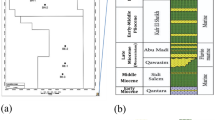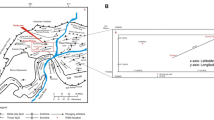Abstract
Determination of the fluid type in a reservoir is considered one of the main essential purposes of the formation evaluation processes. Badri Field, located in the southern part of the Gulf of Suez, is one of the most prolific areas in the Gulf of Suez. Presence of sandstone streaks in Sidri and Baba members within Belayim Formation in some wells within this field of relatively high resistivity signature in electric logs is the main reason to investigate its petrophysical parameters, to delineate the main characterization of these sands, and to evaluate their ability for hydrocarbon accumulation and production. This study aims to estimate the fluid types in these two untested members, especially that they are sandwiched between two productive sandstone zones, Kareem Formation and Hammam Faraun Member. The fluid type can be determined using formation pressure and pressure gradient, which play a great role to differentiate between the different formations’ fluids (oil, gas, and water). Because of absence of pressure data in the studied wells, a new simulation technique was applied using well logging crossplot responses in the different hydrocarbon types (oil and/or gas), which were tested before to estimate the fluid type in the untested two studied zones. These include density-neutron, sonic-neutron, M-N, and matrix identification (MID) crossplots. This can be performed by correlation of the crossplot responses in the two productive sandstone zones: Kareem Formation and Hammam Faraun Member versus the untested studied sandstone zones of Sidri and Baba members, depending on the similarities and the differences between the crossplot responses or signatures in the oil and gas fluids. The results of this approach revealed that the most fluid type in BDR-A8 and BDR-B9 wells is gas in Baba and Sidri zones and oil in the BDR-A9 well for Baba zone.




















Similar content being viewed by others
References
Alsharhan A, Salah M (1994) Geology and hydrocarbon habitat in a rift setting: southern Gulf of Suez. Egypt Bull Can Petrol Geol 42:312–331
Asquith G, Krygowski D (2004) Basic well log analysis: AAPG methods in exploration. Am Assoc Pet Geol Bull, Oklahoma 16:31–35
Atlas W (1995) Introduction to wireline log analysis. Western Atlas International Inc, Houston, Texas
Bosworth W, McClay K (2001) Structural and stratigraphic evolution of the Gulf of Suez Rift, Egypt: a synthesis. In P.A. Ziegler, W. Cavazza, A.H.F Robertson and S. Crasquin-Soleau (Eds.), Peri-Tethys Memoir 6: Peri-Tethyan rift/wrench basins and passive margins. Me´moires du Museum National d’Histoire naturelle de Paris, Memoir 186:567–606
Clavier C, Rust DH (1976) Mid-plot, a new lithology technique. Log Anal 17:16–31
El-Naby AA, El-Aal MA, Kuss J, Boukhary M, Lashin A (2009) Structural and basin evolution in Miocene time, southwestern Gulf of Suez. Egypt Neues Jahrbuch für Geologie und Paläontologie-Abhandlungen 251:331–353
El-Naby A, Ghanem H, Boukhary M, El-Aal MA, Lüning S, Kuss J (2010) Sequence-stratigraphic interpretation of structurally controlled deposition: Middle Miocene Kareem Formation, southwestern Gulf of Suez. Egypt Egypt: GeoArabia 15:129–150
Lashin A, Abd El-Aal M (2004) Seismic data analysis to detect the depositional process environments and structural framework of the east central part of Gharib Province, Gulf of Suez-Egypt. Ann Egypt Geol Surv 27:523–550
Pirson JS (1977) Geologic well log analysis. Gulf Publishing Company, Amsterdam, New York, pp 407–411
Said R (1990) Cretaceous paleogeographic maps. In: Said R (ed) The geology of Egypt. A A Balkema, Rotterdam, pp 439–449
Schechter D (2010) Crossplot. Porosity and lithology, Formation evaluation pete., p 321
Schlumberger (1972) Log interpretation principles, vol 1. Schlumberger Limited, New York, USA, p 112
Schlumberger (1986) Well evaluation conference Schlumberger Ltd., pp 1–31
Schlumberger (1987) Log interpretation principles/applications. Schlumberger Company Publication, Houston, Texas, pp 3–10, ISBN: SMP-7017
Schlumberger (1995) Well evaluation conference—Egypt. Houston, Texas pp 1–87
Schlumberger (1997) Log interpretation charts. Schlumberger Ltd Houston, Texas, pp 72175–77252
Wyllie MRJ (1963) The fundamentals of well log interpretation. New York, Academic Press
Acknowledgments
The authors are grateful to the two reviewers and the editor for the time and the effort they put into their comments that helped improve this paper. The authors express their kind thanks to Prof. Dr. Hussein M. A. Alkhashab, Professor of Applied Geophysics, for his valuable comments to revise this manuscript. Also, deep thanks to the EGPC and GUPCO authorities for their permission to carry out this research and providing the required data. The authors thank the production team of Springer for their efforts to improve the quality of this paper.
Author information
Authors and Affiliations
Corresponding author
Rights and permissions
About this article
Cite this article
Abudeif, A.M., Attia, M.M. & Radwan, A.E. New simulation technique to estimate the hydrocarbon type for the two untested members of Belayim Formation in the absence of pressure data, Badri Field, Gulf of Suez, Egypt. Arab J Geosci 9, 218 (2016). https://doi.org/10.1007/s12517-015-2082-2
Received:
Accepted:
Published:
DOI: https://doi.org/10.1007/s12517-015-2082-2




